Spaying Your Dog: Everything You Need To Know
By admin / June 28, 2022 / No Comments / Pet Dogs
The conversation of having your young pup spayed is certainly going to come up at some point during your dog’s vaccines. Veterinarians are always happy to educate owners on why having your female dog spayed is important, especially if you’re not going to be doing any breeding.
Even if you’re on board with the procedure, there’s always questions to be asked, like what’s the process; how long does it take; what’s their recovery time look like? These are all excellent things to inquire about, so let’s talk about what happens when you drop your dog off for their big spay day!
This is being written in order to give you transparency and is not a guide for the procedure.
This article will also be a little intense, and if you’re not confident with reading the full details? Then please don’t! This may be a little much.
First Decide When you Want To Do It
This is a big decision.
Discuss it with your vet, discuss it with your breeder and check out the latest breed specific data I’ve compiled for you.
When you’ve decided that this process is for your dog and you’re confident you’re doing it at the right time, then book in.

What To Expect At The Vet: The Morning Of Drop Off
The first, and most important step, is to have an established relationship with a veterinarian, preferably the one that is going to be spaying your pup. Ideally, they will also be up to date on vaccinations and appropriately dewormed up to the point of the procedure.
- Meet your vet, preferably before the day of surgery.
- Physical exam to check overall health and condition prior to surgery. (especially heart and lungs)
- Up to date on vaccinations (as much as possible depending on their age).
- Blood work prior to anesthesia to ensure they are not anemic and their kidney and liver function is appropriate.
No matter the age that your dog is, whether they are a puppy or 3 years old, it is crucial that you have met your veterinarian and they have seen your dog is healthy enough to undergo surgery. Always inform your vet if your dog has been having any kind of health issues, no matter how small it may seem.
If your dog needs a microchip, this is the perfect opportunity to have your vet do this!
It’s a pretty big needle, so they would probably prefer to be asleep for it.
After that, your veterinarian should have your pet’s current weight, medical history and condition and they will most likely take it from there. Try not to worry, it’s a big day for you, but not nearly as big of a day as it is for your dog.
What Happens After You’re Gone?
The average clinic will take your dog into the treatment area where the veterinary technicians do the rest of the work until the veterinarian’s part. Assuming that your dog isn’t the only pet that they are performing surgery on that day (because it’s very likely she isn’t), the technicians will obtain their small blood sample in as stress free of a manner as possible and then place your dog in a clean kennel with a blanket to hang out in until the doctor is ready to proceed.
Once your dog’s blood work has been run and the results have been interpreted, if everything looks good then the doctor and techs will begin the process of the spay.
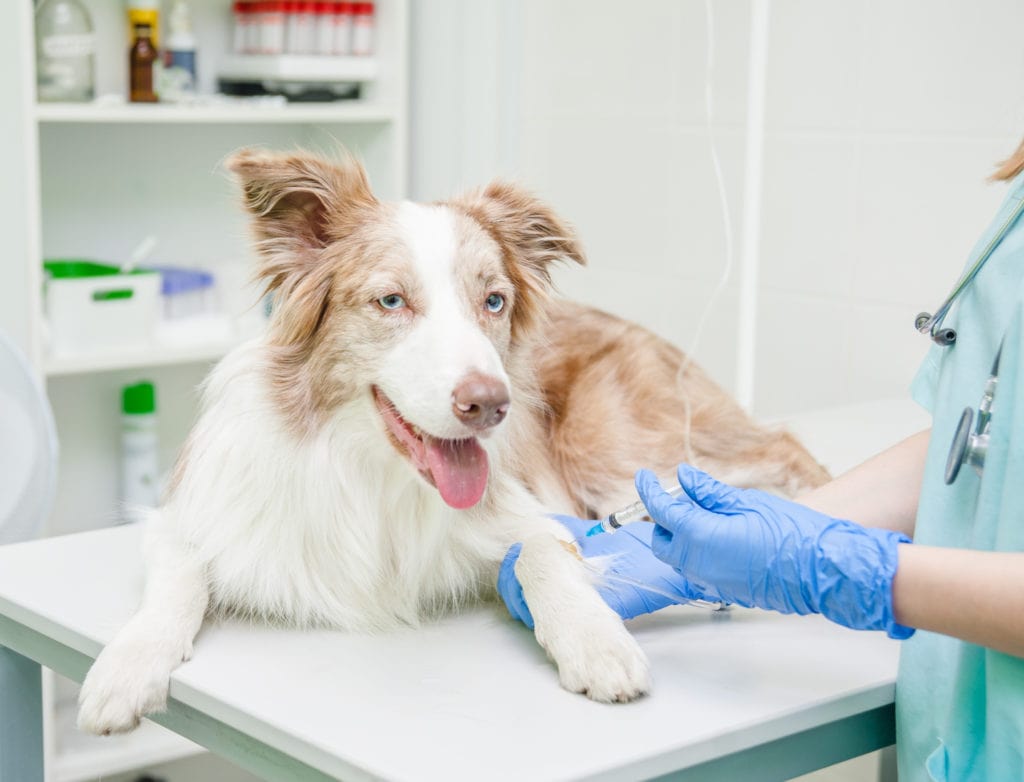
Step 1: Giving Your Dog Their Pre Meds
“Pre meds” is a shortened term for presurgical medications. These are given as an injection and they are typically a combination of two or three agents from four or five drug classes, such as NSAIDs, opioids, anticholinergics, sedatives and tranquilizers.
Now, they certainly don’t give all of those! The average hospital will combine a common injectable opioid with some type of mild sedative to help your dog feel calm and relaxed prior to being induced under anesthesia.
Step 2: IV Catheter And Induction
The next step takes place after your dog has had some time for their pre meds to kick in – typically 20-30 minutes later. Once they are feeling relaxed and the doctor deems them ready to move on, the technician will place an intravenous catheter into your dog’s front arm and from there they will administer their anesthetic induction agent.
An anesthetic induction agent is typically a combination of a benzodiazepine and a cyclohexamine. Propofol is also a common induction agent used in veterinary medicine and human medicine alike. It is in a class all of its own and is unique in its short onset of action and its quick and simple recovery.
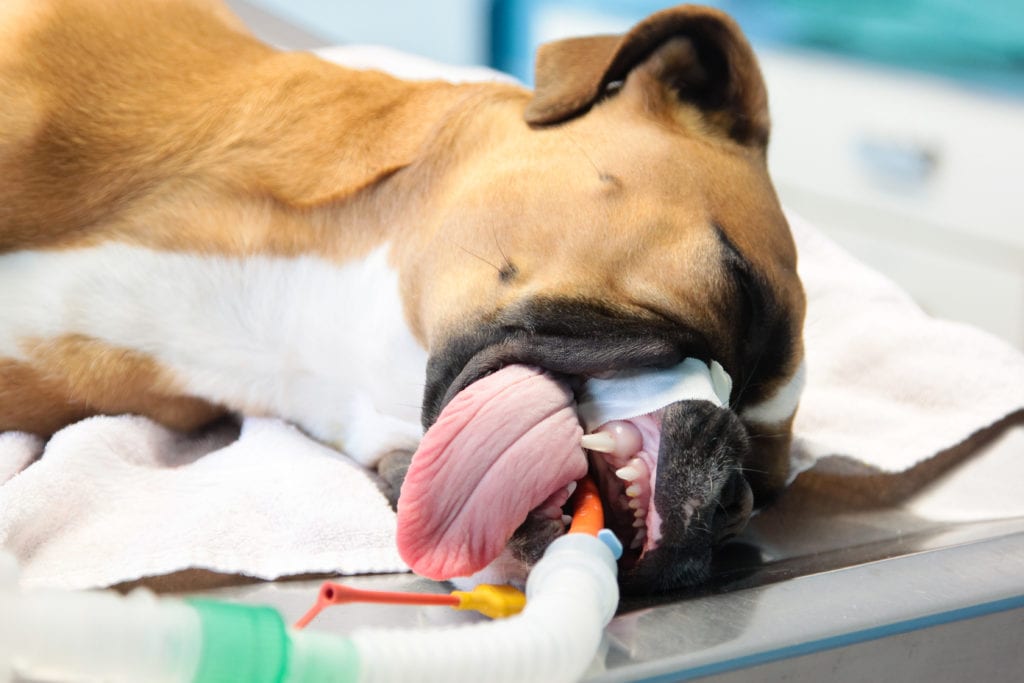
Step 3: Intubation And Transfer To Surgery
After your dog is successfully asleep with their induction agent, the technician will place an endotracheal tube into the pet’s trachea and secure it. Afterwards the tube will be connected to an anesthetic machine that will administer a mixture of oxygen and gas. This is what will maintain them under anesthesia so that the doctor can perform and complete the procedure safely.
Some facilities have a small, portable anesthetic cart that they can move around on wheels in the treatment area. If this is so, they will usually prep the patient for surgery by shaving and giving a mild scrub of the incision area before transferring them into their surgery suite and being hooked up to the larger, stationary anesthesia machine.
Once in surgery, your dog will be hooked up to several pieces of monitoring equipment, consisting of an EKG for heart monitoring, blood pressure machine and IV fluids.
Step 4: Scrubbing The Surgical Site
The cleaning, or “scrubbing”, of the surgical site is extremely important as it sterilizes the area, ensuring that it is free of bacteria. The area should be shaved as close to the skin as possible, which can be particularly tricky depending on the type of hair they have.
Thankfully, a female’s abdomen is pretty easy to shave compared to a pair of balls. However, you do still have to dodge their nipples! No one wants to be called a “nipple-knicker” for the rest of the day by their coworkers.
- The shave: After the area, from the pubis to the bottom of the sternum is shaved (essentially the entire abdomen, stopping at the sides), the technician will then use two cleaning agents to sterilize the incision site properly: gauze soaked with alcohol and gauze soaked with diluted chlorhexidine scrub.
- The “target” scrub: The surgical site should be cleaned first of all debris, then alternating the alcohol and chlorhexidine gauze, the skin will be wiped in a “target” or circular direction starting from the middle and working outward, careful not to overlap, so that the remaining hair and debris is removed.
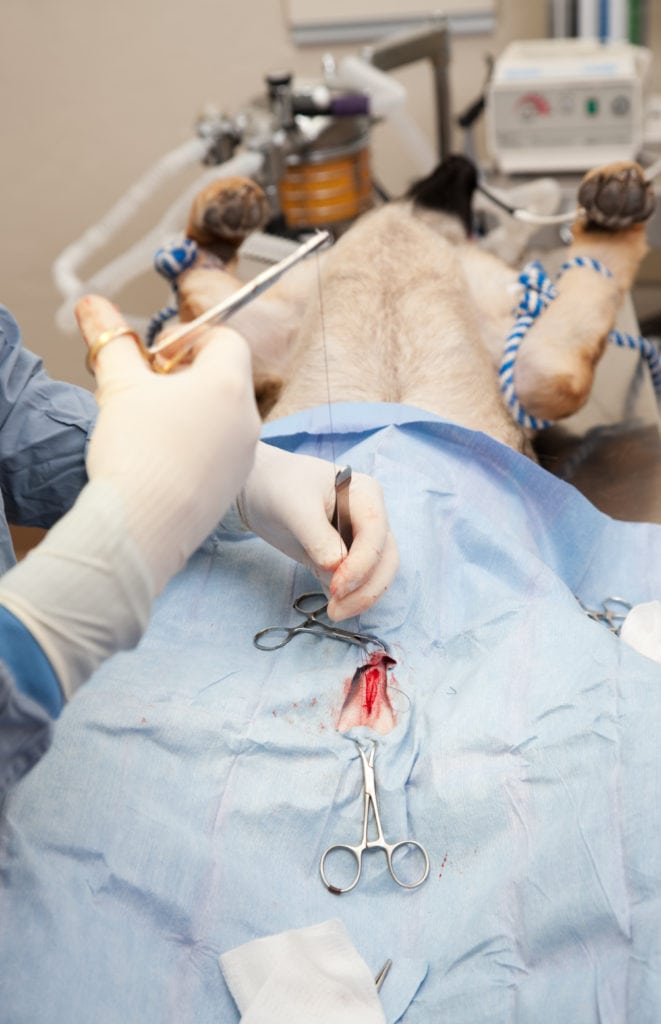
Step 5: The Incision
A spay is also referred to as an ovariohysterectomy and it involves removing both ovaries and the uterus, stopping at the cervix. Once the doctor is gowned-up with sterile gloves and ready to go, they will open their sterile pack and place their sterile drape over the sterile surgical site. Using a scalpel, they will then make their initial cut.
The incision for a spay (also known as an “ovariohysterectomy”) will be slightly larger than the one made for a neuter. It starts just below the umbilicus (belly button) and stops about an inch or so below it. The incision will need to be larger if the female is mature, overweight or has had puppies. Another reason why it is better to have them spayed while they are young: a smaller incision.
Step 6: Identifying The Female Reproductive Organs
There are two ways to perform a spay or ovariohysterectomy, the traditional method that involves making a single incision into the abdomen, or the laparoscopic method which involves using several robotic arms. The laparoscopic method sometimes only includes an ovariectomy, which is where the doctor removes only the ovaries and not the uterus.
This procedure is discussing the traditional spaying technique that the majority of veterinarians still use today.
After making their incision into the abdomen and cutting through the several skin layers and body wall midline, the doctor will then have to find and identify your dog’s reproductive organs, starting with the ovaries.
- Separate the ovaries: The ovaries should be loosely attached to the pet’s abdominal body wall and the doctor will gently separate the ligaments that are holding it in place. Once this happens, they can then ligate or “tie-off” the vessels and tissue that the ovary was attached to, from there they will cut it away from the body wall but it is still attached to the uterine horn (fallopian tube).
- Clamping above the cervix: One both ovaries have been ligated and separate from the body wall and abdomen, the doctor will then clamp above the cervix with hemostats and ligate that as well. Once the cervix has been tied-off, the doctor can proceed to remove both the uterus and the ovaries safely.
In some cases of a very large or vascular uterus, the doctor will opt to use a transfixing ligature over the cervix. Transfixing ligatures are occasionally used by doctors to ensure that the ligature doesn’t slip once it is tucked back into the body. This is another method to prevent bleeding post operatively.
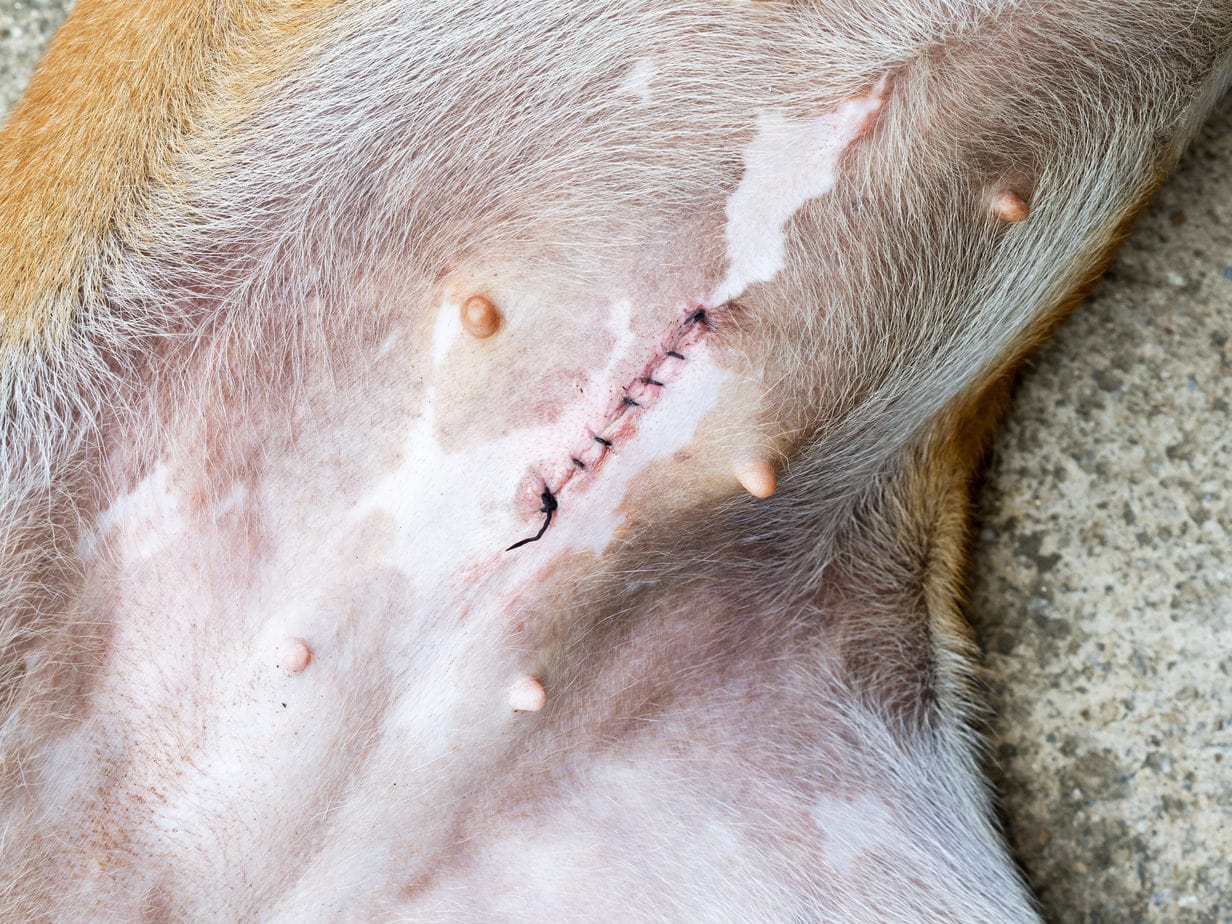
Step 7: Closing The Incision Site
Once the doctor has ensured there is no bleeding, they can begin moving into the phase of surgery where they close the incision site. With a spay, this involves two layers of sutures: closing the abdominal body wall, and the subcutaneous layer.
The technician will apply a drop or two of glue over the incision site and from there it’s time to wake up!
Step 8: Wake Up And Recovery After A Spay
The process of waking up and extubation (removal of the ET tube) should be rather simple, but a spay is much more invasive than a neuter, which can make their recovery time slightly longer. Not to say that boys don’t have it hard too! But let’s be honest, having a doctor cut out your insides is probably a little more painful.
As your dog is waking up from anesthesia, the technician will check their temperature and provide them with a gentle heat source and some blankets. While they are still asleep, most hospitals give them another pain injection as well as an injectable antibiotic.

Step 9: Tech Checks And Discharge
The technicians will check on your pet frequently throughout the next few hours and ensure there is no abnormal bleeding and that they otherwise appear to be recovering appropriately.
Your pup should be sent home with an Elizabethan collar, aka “cone of shame” or “lampshade of doom” and several days of an anti-inflammatory pain medication.
Step 10: Recovery At Home
When it comes to spays, females need to be particularly careful, as they could easily herniate their incision if they are too active or manage to lick at the surgical site. If you’re not watching them, they need to have their cone on!
With that being said, puppies will be puppies, so do the best you can! Reach out to your vet for a sedative if you think it’s necessary for the recovery process. The older that your dog is, the longer you can expect their recovery time to be, however, the average female will take about 10-14 days before major healing has occurred.
If you’re looking for some fun tips for keeping your puppy happy but also calm and content during their recovery from surgery, check out these 12 ideas!
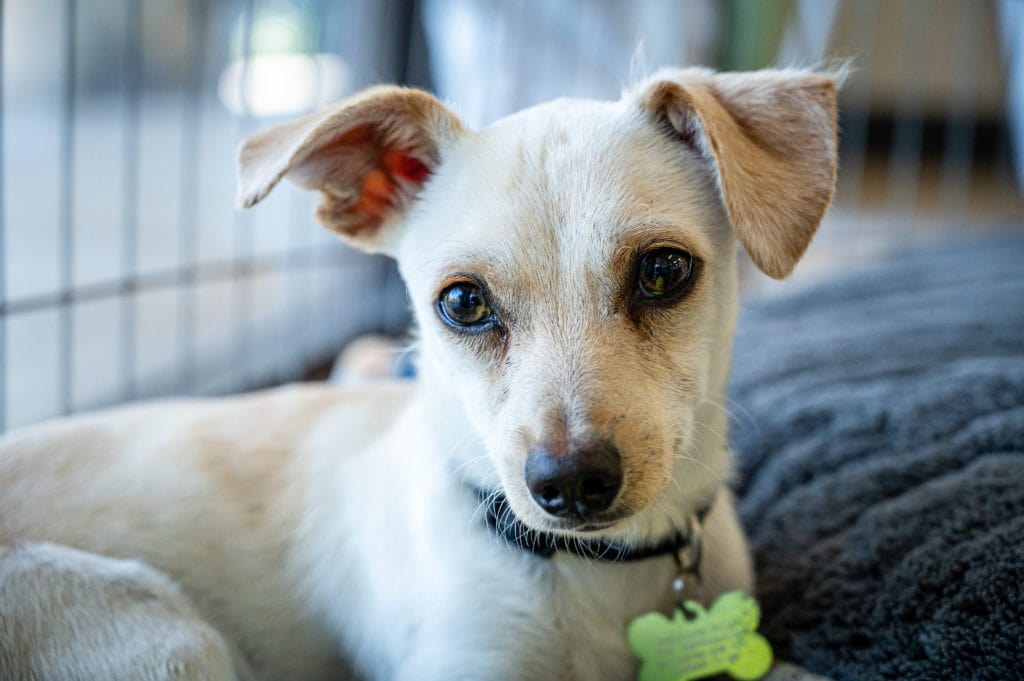
Knowledge Is Power
I’m a huge fan of giving you guys everything you need to know to make informed decision. So, demystifying this process was my only goal for this piece.
I know it’s a big procedure, and I know it’s not the easiest thing on your dog, but it does come with some good benefits.
From a Training point of view, remember when you do go back to walking that you should reintroduce them gently. Pain is a huge reason for your dog to get cantankerous and it could lead to a bite. So, please do (essentially) increase your distance when re-socialising your dog to prevent behavioural issues.
If you need more info about your dogs spay surgery? Head to the Spay Info Center where you can find all the data you might need.
Author, Ali Smith
Ali Smith is the Positive Puppy Expert, dog trainer and is the founder of Rebarkable. She is passionate about helping puppy parents get things right, right from the start. To help create a puppy capable of being a confident and adaptable family member and keep puppies out of shelters.
Ali has won multiple awards for her dog training, and has had her blog (this blog!) rated as 2021 & 2022 worlds’ best pet blog!
Link to originalRebarkable
